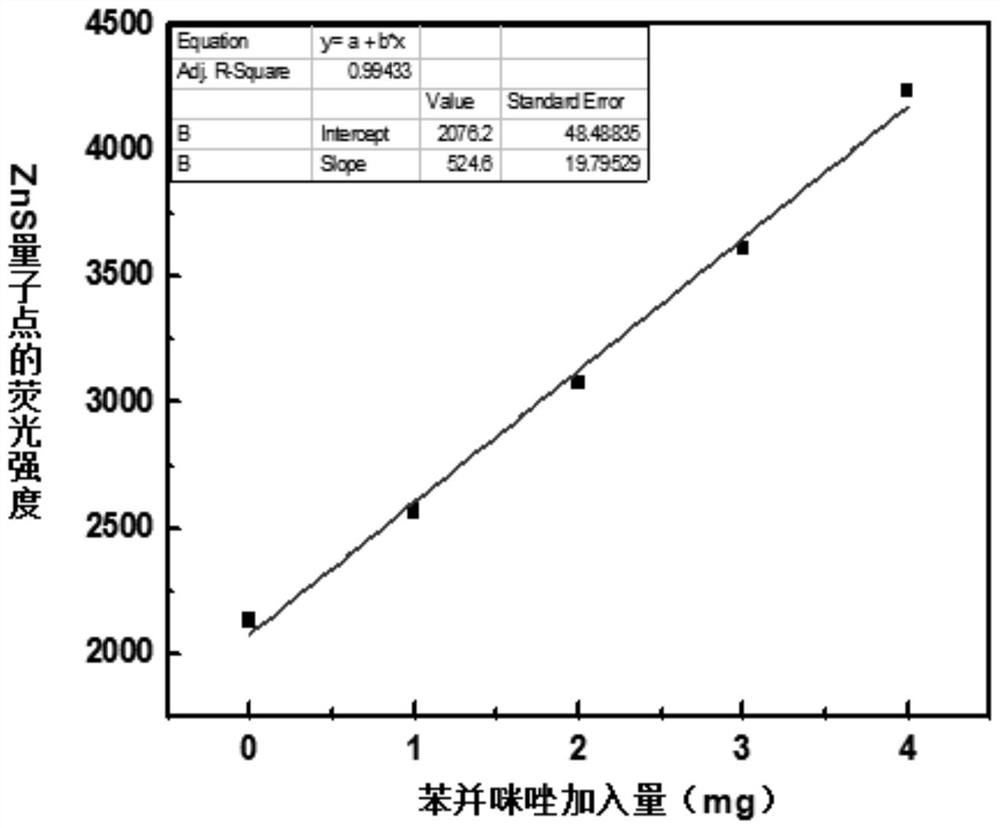Detection method of free zinc ions
A detection method, zinc ion technology, applied in the field of quantum dots, can solve the problems of cumbersome operation and poor sensitivity
- Summary
- Abstract
- Description
- Claims
- Application Information
AI Technical Summary
Problems solved by technology
Method used
Image
Examples
Embodiment 1
[0061] The above qualitative detection method is described in detail below by taking ZnS quantum dots as an example.
[0062] (1) Provide 2.0 g of ZnS quantum dots modified with 0.5 g of trioctylphosphine, dissolve in 20 ml of chloroform, add 0.6 g of ethanedithiol, and perform ligand exchange under the conditions of microwave power 30W and reaction time of 12 minutes . After the ligand exchange is complete, methanol is added for centrifugation, and after washing and drying, redissolve in 20ml of chloroform.
[0063] (2) The initial fluorescence intensity value of ZnS quantum dots after ligand exchange was measured by a fluorescence spectrometer to be 2134. When heated to 40 degrees Celsius, add 0.1g of titanium dioxide catalyst, then dropwise add 0.5ml of benzimidazole solution with a concentration of 2mg / ml, and measure the fluorescence intensity value every time 0.5ml of benzimidazole solution is added until the fluorescence intensity increases initially around 100% of th...
Embodiment 2
[0067] The above separation method will be described in detail below by taking CdS@ZnS quantum dots as an example.
[0068] (1) Provide 35.0 g of CdS@ZnS quantum dots modified with 5.5 g of oleylamine, dissolve them in 280 ml of chloroform and add 8.1 g of 1,3,4-butanetrithiol, microwave power 900W, reaction time 90 minutes Ligand exchange under conditions. After the ligand exchange is complete, methanol is added for centrifugal washing, and after washing and drying, it is redissolved in 280 ml of chloroform.
[0069] (2) The initial fluorescence intensity value of CdS@ZnS quantum dots after ligand exchange was measured by a fluorescence spectrometer to be 3492. When heated to 80 degrees Celsius, add 4.5g of palladium carbon catalyst, then dropwise add 0.8ml of quinoline solution with a concentration of 2mg / ml, and measure the fluorescence intensity value every time 0.8ml of quinoline solution is added until the fluorescence intensity increases to the initial value 140% or s...
Embodiment 3
[0073] The above separation method will be described in detail below by taking CdZnSe alloy quantum dots as an example.
[0074] (1) Provide 15.8g of CdZnSe alloy quantum dots modified with 2.4g of oleic acid, dissolve in 100ml of chloroform and add 3.1g of 1,2,3,4,8-octanepentathiol, microwave power 200W, reaction time Ligand exchange was carried out at 30 min. After the ligand exchange is complete, methanol is added for centrifugal washing, and after washing and drying, it is redissolved in 100 ml of chloroform.
[0075] (2) The initial fluorescence intensity value of CdZnSe alloy quantum dots after ligand exchange was measured by a fluorescence spectrometer to be 2621. When heated to 65 degrees Celsius, add 2.5g of anhydrous aluminum chloride catalyst, then dropwise add 0.3ml concentration of 2mg / ml phenazine solution, and measure the fluorescence intensity value every time 0.3ml phenazine solution is added until the fluorescence intensity Increase around 125% of the init...
PUM
 Login to View More
Login to View More Abstract
Description
Claims
Application Information
 Login to View More
Login to View More - R&D
- Intellectual Property
- Life Sciences
- Materials
- Tech Scout
- Unparalleled Data Quality
- Higher Quality Content
- 60% Fewer Hallucinations
Browse by: Latest US Patents, China's latest patents, Technical Efficacy Thesaurus, Application Domain, Technology Topic, Popular Technical Reports.
© 2025 PatSnap. All rights reserved.Legal|Privacy policy|Modern Slavery Act Transparency Statement|Sitemap|About US| Contact US: help@patsnap.com



